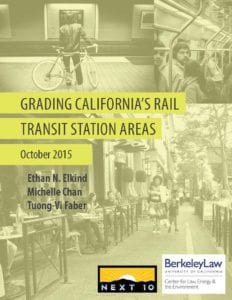October 2015
- Los Angeles County Metro Rail
- Sacramento Regional Transit (RT)
- San Diego Metropolitan Transit System (MTS)
- San Francisco Bay Area Rapid Transit (BART)
- San Francisco Municipal Railway (MUNI)
- Santa Clara Valley Transportation Authority (VTA)
Why grade these neighborhoods? The most effective rail systems with the highest ridership serve significant concentrations of jobs, retail, services, and housing around the stations and along the corridors they travel, particularly those within one-half mile of the station.
The report divided rail transit station areas into three types: residential, employment and mixed and calculated grades based on 11 key indicators including walkability, ridership levels, existing land-use and permitting policies, affordability and transit quality.
Key Findings
The grades reveal that high-performing stations are often in the middle of transit systems in downtown-like environments, while the poorest-performing stations are often located at the outer edges of the rail systems and the urban areas. Low density, auto-oriented areas, even when graded against similar place types, scored poorly. Overall, high-performing rail transit stations serve significant concentrations of housing, jobs, and other amenities in a walkable, equitable environment.
The report gives the highest grade statewide to San Francisco Municipal Railway’s (MUNI) Market Street and Church Street station, and the lowest grade to San Diego Metropolitan Transit System’s Gillespie Field Station.
Download the Report:
Grading California’s Rail Transit Stations (Oct. 2015)
See Our Op-Ed in the San Diego Union Tribune:
Driving development of transit-oriented districts (Oct. 8, 2015)
For More Information:
Contact Ethan Elkind, Director, Climate Program, Center for Law, Energy & the Environment at UC Berkeley Law.
This work was made possible through the support of Next 10.